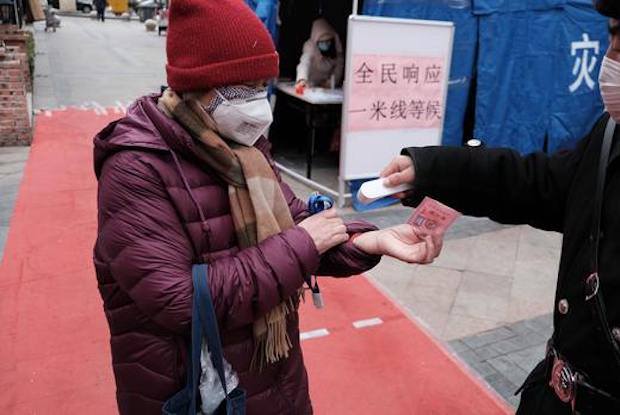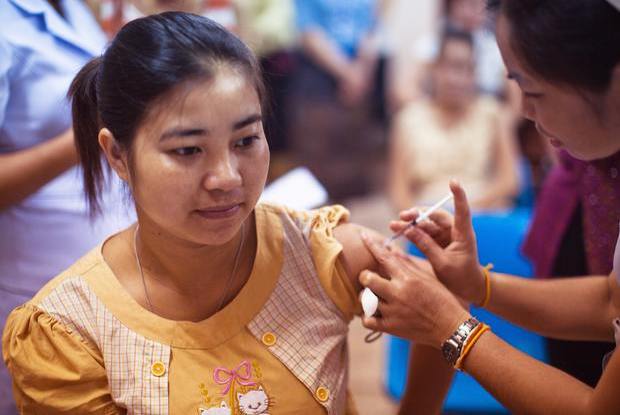Table of Contents
III. Why is it spreading so quickly?
What is COVID 19?
For the last several weeks it has been virtually impossible not to hear about the virus sweeping the world: COVID-19. Everyone has heard of it, but understanding its origin and cause is a bit more complicated. COVID-19 is a coronavirus, which is part of a large family of viruses. These viruses are common in people and certain animals like camels, cattle, cats, and bats. It is rare that animal coronaviruses infect people, but it is not unprecedented. MERS-CoV and SARS-CoV are previous deadly examples of this rare animal to human transmission. [1]
History of COVID-19
Scientists have connected COVID-19 to a single animal reservoir, just like its predecessors MERS-CoV and SARS-CoV. As of right now, COVID-19 has been linked to a seafood and animal market in Wuhan, China. These “wet markets” are common in many places in Asia, but they can be breeding grounds for bacteria and infections. Animals are often slaughtered in the markets to ensure freshness. This close human and animal contact makes it easy for viruses to jump from exotic animals to people. SARS originated in a similar market environment in 2002. [2]

Bats have been the vehicle for previous deadly viruses, but no bats are sold at the Wuhan market, so scientists believe another exotic animal is responsible for the current coronavirus outbreak. There are still a lot of unknowns surrounding the origin of this virus, but some scientists posit that the pangolin has a similar RBD (receptor-binding domain) to the SARS-CoV. The pangolin is an armadillo-like mammal that is found in Asia and Africa. The coronavirus could have possibly transmitted from a pangolin (or another animal host) to a human. A second plausible scenario may involve a non-pathogenic version of the virus transmitting from animal to human and then evolving into its current pathogenic form. [3]
The first cases of COVID-19 began to appear in Wuhan in early December and China reported the spread of this unknown illness to the World Health Organization on December 31 of last year. The virus soon began to spread to other countries like Thailand and the United States sometime earlier this year. In late January, China began an extensive lockdown of the infected area, which impacted over 36 million people. [4]
Why is it spreading so quickly?
COVID-19 is still being studied, but scientists believe it is transmitted so easily because many people with the virus only display mild symptoms or no symptoms at all. Air travel is also much more prevalent than in previous viral outbreaks. People love to travel and if you aren’t showing symptoms, then people would rather not forfeit their travel plans. In a lot of cases, people are not aware they even have the disease and could unknowingly infect everyone they come in contact with. Heightened awareness of this virus, travel restrictions, and the use of personal protective measures can help prevent further “stealth transmissions.”[5]
Doctors are still studying how COVID-19 is spread, but isolation is advised for people who have been diagnosed. The CDC says that coming into contact with COVID-19 droplets (from coughing or sneezing) is the main cause of transmission. [6]
a. Symptoms
The symptoms of COVID-19 appear to vary slightly from person to person, but it appears to target the respiratory system. Some common symptoms can include:
- Fever
- Cough
- Shortness of breath
This virus may appear like the common cold or flu, but it is important to stay isolated at the first signs of these symptoms. As of right now, doctors seem fairly confident that the majority of COVID-19 cases will improve on their own. It is still important to stay isolated because this virus could have drastic effects on the immunocompromised and the elderly. It is important to call your local health authority or seek medical attention if you experience more severe symptoms, including:
- Difficulty breathing
- Persistent pain in the chest
- Bluish lips or face
- Confusion or inability to rouse [7]

Prevention techniques
There are several ways to decrease the transmission of COVID-19. The best way to prevent illness involves lowering your risks of being exposed to the virus. It is thought to spread from person to person who are within 6 feet of each other or through respiratory droplets from an infected person. To limit your chances of transmitting COVID-19 it is recommended you:
- Clean your hands often. Wash your hands for at least 20 seconds with soap and water, especially if you have been in a public space with sneezing or coughing people.
- Use hand sanitizer that contains at least 60% alcohol.
- Avoid touching your eyes, nose, or mouth with unwashed hands.
- Avoid close contact with sick people.
- Practice social distancing by putting space between you and other people. This is even more important if you have a pre-existing condition that puts you at a higher risk for getting sick.
- Stay home if you’re sick!
- Cover your nose and mouth if you sneeze, dispose of tissues immediately, and wash your hands.
- Wear a facemask if you are sick and have to be around other people.
- Clean and disinfect commonly touched surfaces in your home. [8]
a. Prevalence
It is early in the spread of the virus, but as of March 20, 2020 there have been over 16,000 cases of coronavirus in the United States and this number will continue to grow if people don’t exercise the necessary precautions. With simple measures like washing your hands and avoiding unnecessary travel, we can flatten the curve to prevent a spike in cases. The virus has been reported in every state in the union, so proper measures can prevent this pandemic from claiming more lives and disrupting everyday life. [9]
UPDATE: Update: As of June 26, 2020 the CDC reports that there have over 1,677,604 reported cases of the COVID-19 virus in the United States since the beginning of March 2020. It is important to follow the instruction of federal and local governments and practice social distancing, so we can flatten the curve together. If you are isolated with your family, have one family member perform the essential activities, like grocery shopping or going to the pharmacy. Tasking one family member for these activities limits a household’s possible exposure to the virus. [13]
Is a cure on its way?
Many countries have fast-tracked funding to speed up the process of getting a vaccine to the public. As of mid-March, a clinical trial of a proposed vaccine to protect against coronavirus was started at Kaiser Permanente Washington Health Research Institute (KPWHRI) in Seattle, Washington. These initial studies will evaluate different doses of the experimental vaccine for its safety and ability to induce an immune response in the participants. This is the first of multiple steps needed for a vaccine to reach approval for public use, but scientists are working tirelessly to make this vaccine a reality. [10]
Creating a vaccine from the ground up takes a lot of time and clinical trials, so some scientists have been looking at other medications in hopes that they may have an effect on the symptoms of COVID-19. In a speech to the American public, President Trump suggested that there are several medications that scientists are considering for COVID-19 use. [11]
As of Wednesday March 25, 2020 Italian researchers have found that the COVID-19 virus is slow to mutate, which is good news for a future vaccine. This new information is from the National Institute for Infectious Diseases in Rome and the Forensic Division of the Department of Biomedical Sciences and Public Health at Ancona University Hospital. These two teams compared COVID-19 and SARS and found that both viruses remain stable across multiple transmissions among individuals and populations. Because the COVID-19 virus is not mutating quickly, then a vaccine will be broadly effective for at least a few years at a time. The vaccine may not be ready for several months, but when it is available to the public it will likely tamper further outbreak. [15]
As of April 2, 2020 an international team led by Dr. Josef Penninger from the University of British Columbia reports finding a possible trial drug effective in the treatment of COVID-19. This trial drug has been shown to block the cellular door that SARS-CoV-2 uses to infect its hosts. The new study examines key interactions of SARS-CoV-2 (the virus that causes COVID-19) on the cellular level, as well as how the virus can infect blood vessels and kidneys. Scientists have targeted ACE2, which is a protein on the surface of the cell membrane. This protein may be the key to a successful treatment method. Working with this protein may lead to a therapy that specifically targets the gate the virus must take to infect us. [19]
a. Some possible medications may include:
Ivermectin: As of April 7, 2020, Australian researchers have found promising results with the use of this drug. Ivermectin has been used for decades and doctors typically prescribe it to treat scabies, lice, and other infections caused by parasites. The Antiviral Research journal reports that ivermectin prevents infected COVID-19 cells (SARS-CoV-2) from reproducing. In other studies, the drug has been shown to work against dengue fever and viruses similar to the coronavirus, like the West Nile virus. The drug is still in the early phases of testing and it is important for people to avoid self-medicating until more research is known about ivermectin. [20]
Vitamin C: Vitamin C is not a prescription medication, but as the pandemic continues, the use of the vitamin is being used more and more. High-dose vitamin C is being used for some critically ill COVID-19 patients. Because there is not a fully approved medication for this virus, hospitals and doctors are pulling out all the stops to find any sort of treatment that could lessen severe symptoms. The CDC has not specifically mentioned high-dose vitamin C, but they do cite that the vitamin is being tested for its therapeutic benefits along with several other medications.
Vitamin C is an essential nutrient that our body does not create on its own, but it is important not to overdo it with the vitamins. Like any substance, taking too much vitamin C can cause serious side effects. Studies show that consuming more than 2,000 mg can lead to nausea and diarrhea. [18]
Plaquenil (hydroxychloroquine):Plaquenil is a medication used to treat malaria infections caused by mosquito bites as well as symptoms of auto-immune diseases. These diseases may seem unrelated to coronavirus, but more uses of hydroxychloroquine are being discovered. This drug has an anti-inflammatory effect which is helpful in treating joint inflammation and skin manifestations of lupus. Researchers in China and France have also studied these drugs as treatments for pneumonia caused by the coronavirus. The World Health Organization is expanding trials of Plaquenil to fight respiratory issues caused by the virus. [12]
As of March 27, 2020, the WHO is still conducting clinical trials of hydroxychloroquine, but some researchers are suggesting that this medication may do more harm than good. It has many side effects and can, in rare cases, harm the heart. Chloroquine and its derivative hydroxychloroquine can cripple the virus, but the doses needed are high and could cause severe toxicity, especially in those who are self-administering the medication. These medications will continue to be studied as part of the WHO’s SOLIDARITY clinical trials. [16]
As of March 30, 2020 the FDA has given the Trump administration emergency approval to distribute thousands of anti-malarial drugs to hospitals all across the country. The studies of hydroxychloroquine have been small and not entirely conclusive. In some of these small studies, hydroxychloroquine has shown positive effects on COVID-19 patients suffering from acute respiratory problems. Health experts are warning that the side effects of these anti-malarial drugs will become more apparent with wide-spread use. One serious side effect of this drug is vision loss (retinopathy).
These drugs are also used for patients suffering from lupus and rheumatoid arthritis, so health experts worry about sapping the supply of hydroxychloroquine. The patients already prescribed this medication are having an increasingly hard time getting their drugs in some parts of the country due to drug hoarding and the new widespread use of hydroxychloroquine in hospitals. [17]
As of May 29, 2020 the results of hydroxychloroquine testing are starting coming out. Many scientists are raising concerns over the use of this drug as a treatment for the novel coronavirus. One study at the Brigham and Women's Hosptial in the United States found that treatment with hydroxychloroquine and chloroquine showed no benefit to those affected with the virus. Heart arrhythmia has also been discovered as a potentially life-threatening side effect of hydroxychloroquine. The World Health Organization has temporarily suspended the use of these drugs in their wide-sweeping SOLIDARITY trial. [2]
Remdesivir: This drug has previously been used as an Ebola treatment and this antiviral drug has been found to work against SARS and MERS. This is a promising development because SARS and MERS are fellow coronaviruses. Remdesivir is an antiviral medication that works by shutting off the virus’ ability to replicate inside cells. This drug has also been pushed to the forefront of trials in combating COVID-19.

Lopinavir/Ritonavir: Kaletra is an HIV drug which combines two antiviral medications, lopinavir and ritonavir. These drugs work by blocking enzymes that help viruses replicate. Kaletra has found success in preventing SARS from replicating and maturing. The WHO is launching further studies to see if this antiviral medication can have positive effects on COVID-19 patients as well.
As of April 21, 2020, a small randomized study in China found that the use of Kaletra has not been as successful as originally thought. Kaletra is used to stop the replication of HIV in the body and scientists hoped it would have a similar effect on the coronavirus. A recent trial found that there was no marked difference in symptoms for those who took Kaletra while undergoing COVID-19 treatment. There are still several trials testing this drug, so further information about the effectiveness of Kaletra will continue to come out. [21]
Interferon-beta: The WHO SOLIDARITY trial is also combining lopinavir/ritonavir with interferon-beta. This molecule is involved in regulating inflammation in the body and has shown positive effects in marmosets infected with another coronavirus, MERS. This combination drug is now being tested in MERS patients in Saudi Arabia. This treatment may be risky for those with severe cases of COVID-19 because it may lead to increased tissue damage. The positive effects of interferon-beta for milder cases of COVID-19 will be tested. [14]
Favipiravir (Avigan): Favipiravir is a Japanese anti-flu drug that has, so far, seen some positive outcomes in coronavirus clinical trials in China. Chest scans have shown that there is less lung tissue damage in those who have taken this drug. [11]
Facts and figures of COVID-19 are shifting daily, so it is vital to stay up to date on current news and follow the proper protocols put forth by local and national governments. It is important not to get bogged down with information about this virus and people should seek trusted news sources for more information. It is up to the individual to take the preventative measures that will benefit society at large and eventually eliminate this virus. Check back to this website for further updates on COVID-19 as it continues to unfold.
The content provided in this article is based on thorough research and in some cases, reviewed by a medical professional. Our goal for the information is to provide helpful, general health informational. It is not intended as a substitute for professional medical advice.
